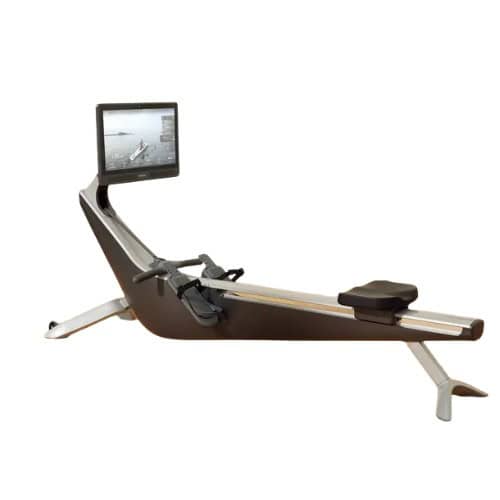After testing Hydrow’s original flagship model, here’s why the Origin becomes the best choice when you catch it at the right price.
Features a 22-inch rotating touchscreen, premium aluminum and steel frame, and the same electromagnetic resistance as all Hydrow models. The rotating screen makes it ideal for both rowing workouts and off-rower content like yoga and strength training.
What We Liked
- ✓ Excellent rowing performance – Same smooth resistance as Wave and Arc
- ✓ 22-inch rotating screen is the sweet spot – Better than Wave’s 16″, more practical than Arc’s 24″
- ✓ Premium metal frame – Aluminum and steel construction feels substantial
- ✓ Very quiet operation – Quieter than Arc, nearly as quiet as Wave
- ✓ Frequently goes on sale – Often discounted below Wave’s price
- ✓ Screen rotation is genuinely useful – Makes off-rower workouts much easier
- ✓ Build quality is outstanding – No creaks or durability issues after months
- ✓ Content library is fantastic – Over 5,000 immersive workouts
What Could Be Better
- ⊘ No advanced HydroMetrics – Missing detailed analytics found on Arc
- ⊘ Heavy and difficult to move – 145 lbs makes repositioning challenging
- ⊘ Vertical storage kit costs extra – $80 add-on for upright storage
- ⊘ Ships via freight – Less convenient than Wave’s UPS delivery
The Hydrow Origin has a pricing puzzle that’s worth understanding.
At its list price of $2,195, the Origin sits awkwardly between the Wave ($1,995) and the Arc ($2,295). You’d be paying $200 more than the Wave for a rotating screen and metal frame, while sitting just $100 away from the Arc’s advanced HydroMetrics.
But here’s what matters: Hydrow frequently discounts the Origin. As I’m writing this, it’s on sale for $1,895, making it $100 cheaper than the Wave and $400 less than the Arc.
At that price, the Origin becomes the sweet spot in Hydrow’s lineup.
I tested the Origin extensively alongside the Wave and Arc. I assembled it, rowed hundreds of workouts on it, and compared every aspect of the experience. The Origin is an excellent rowing machine with premium build quality, smooth performance, and a 22-inch rotating screen that’s genuinely useful for off-rower workouts.
The machine itself isn’t the question. It’s outstanding. The question is whether the price makes sense, and the answer depends entirely on whether you’re catching it on sale.
If you’re considering the Origin, this review will help you understand what you’re getting, how it compares to the Wave and Arc, and when it makes sense to buy.
Table of Contents
▼What’s in the Box
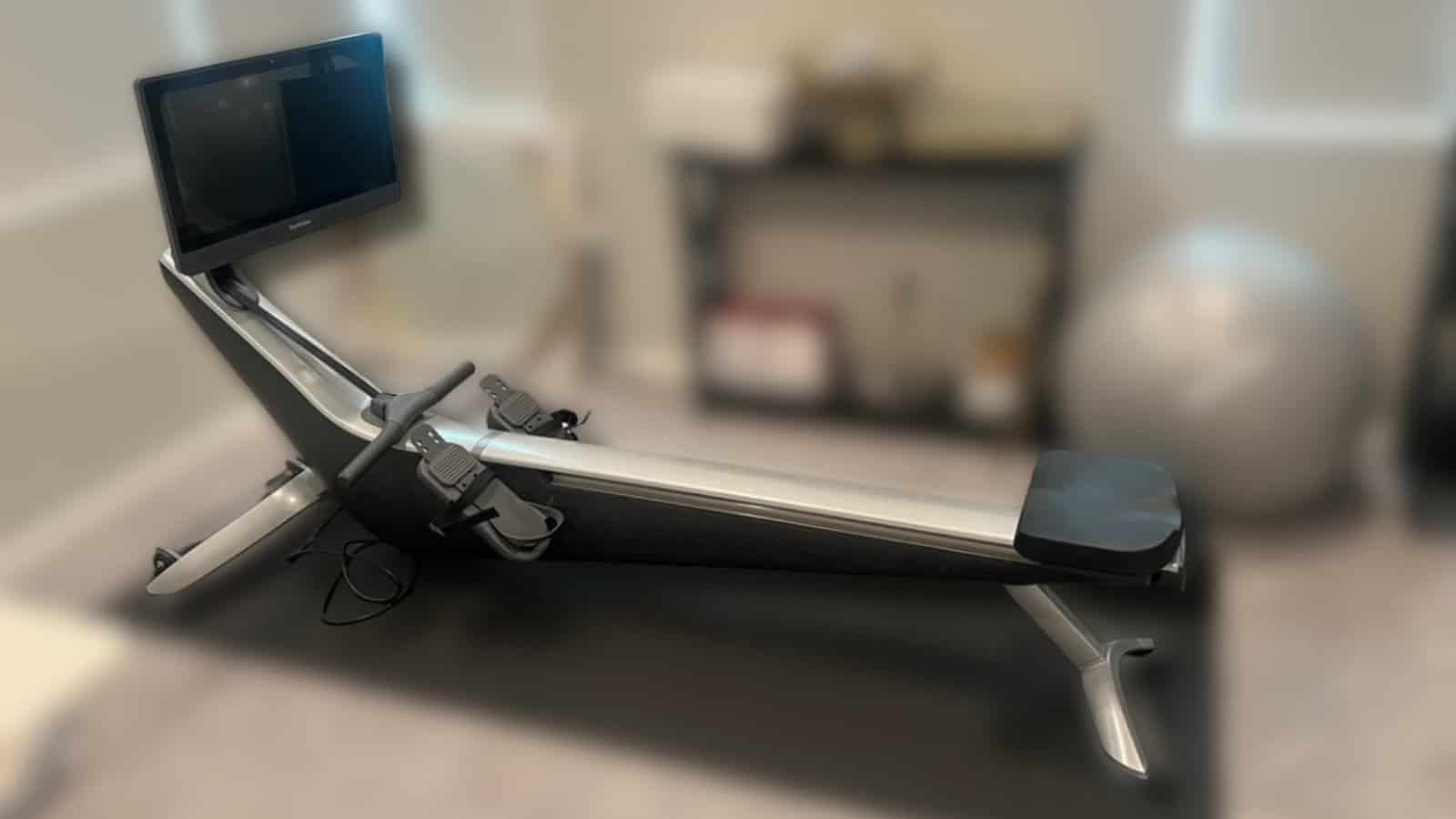
The Origin ships on a freight pallet like the Arc. The box measures approximately 91 inches long, and the total shipping weight is around 197 pounds. You’ll need two people for delivery day, and if you live in an apartment without easy freight access, this can be a logistical challenge.
Inside the box:
- Main rower frame (front and rear sections)
- 22-inch HD touchscreen monitor
- Monitor arm assembly
- Seat with 10 rollers
- Handle with rubberized grip
- Adjustable footrests with straps
- Hardware kit (bolts, washers, screws)
- Allen key and screwdriver (all tools included)
- Power cable
- Assembly instructions
Packaging is thorough with foam inserts and protective materials. Everything arrived undamaged in my shipment.
Assembly & Setup
Assembly took me 50 minutes with a second person helping. The instructions say 45-60 minutes, which is accurate.
The process is nearly identical to the Arc:
- Remove packaging and cut plastic straps carefully.
- Attach front and rear stabilizer legs using the Allen key and supplied bolts. Tighten evenly at all corners.
- Slide the seat onto the rail (no tools needed).
- Mount the monitor arm. This requires precise alignment and benefits from having someone hold the arm steady.
- Attach the 22-inch touchscreen using the screwdriver. Top two screws first, then bottom two.
- Connect handle, footrests, and cable management clips.
- Final bolt check. Hand-tighten everything.
- Plug in power cable.
The assembly process is well-designed. Everything is labeled, the instructions are clear with photos, and all necessary tools are included.
Working solo is possible but more awkward, especially when mounting the monitor arm. Having a second person to stabilize components makes the process smoother.
Design & Build Quality
The Origin measures 86 inches long, 25 inches wide, and 47 inches high. The seat sits 16 inches off the floor. These dimensions are nearly identical to the Arc.
At 145 pounds, the Origin is slightly lighter than the Arc (147 pounds) but still substantially heavier than the Wave (102 pounds).
Frame Construction
The frame uses aluminum and steel construction, identical to the Arc. It feels solid and premium.
Even during high-intensity intervals at 30+ strokes per minute, there’s zero wobble or flex. The frame stays planted exactly where you position it.
The matte finish holds up well to regular handling. After months of use, there are no significant marks or wear on the coating.
Is the metal frame noticeably better than the Wave’s polymer? In terms of feel, yes. The Origin feels more substantial and premium when you first set it up. In terms of performance during actual workouts, no. Both are equally stable.
Seat and Rail
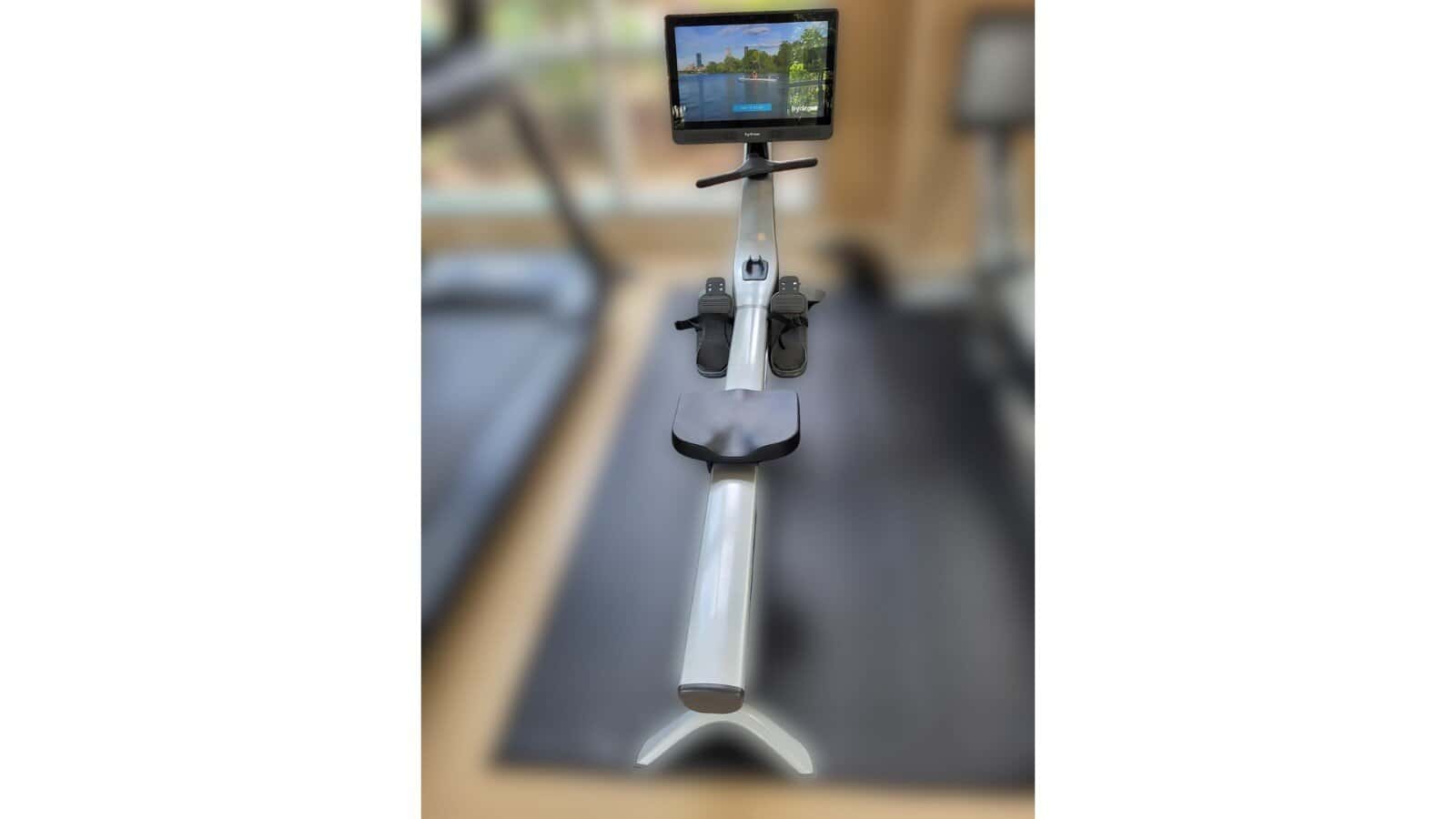
The seat runs on 10 industrial-grade rollers, creating a smooth, quiet glide along the rail. The movement is excellent. Nearly silent.
The rail length is 47 inches, same as the Wave and Arc. Taller users (up to 6’4″-6’8″ with a 36-inch inseam) get full range of motion without feeling cramped.
The seat padding is firm and comfortable. I’ve done 45-minute rows without discomfort, which matches my experience on the Arc and Wave.
Handle and Footrests
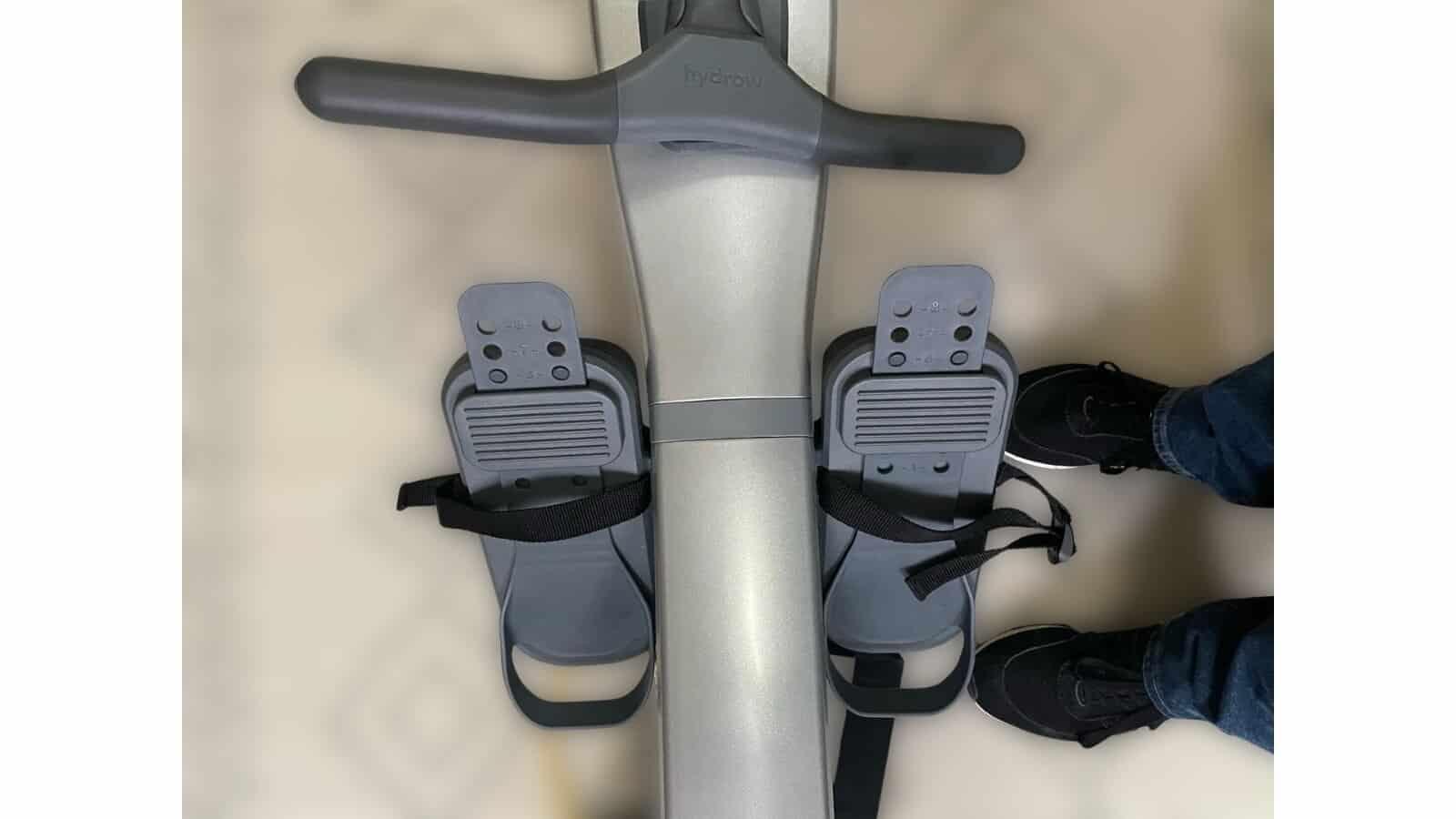
The handle is the standard Hydrow ergonomic grip found on all models. Cushioned, comfortable, with enough texture to prevent slipping during sweaty workouts.
The footrests are fully adjustable and secure with Velcro straps. They work well and stay tight throughout workouts.
Performance & Rowing Experience
The Origin uses the exact same electromagnetic resistance system as the Wave and Arc. Same 300 levels of resistance, same drag factor range (50-300), same default setting of 104.
After testing all three models extensively, I can confirm the rowing performance is identical. The stroke feel, resistance response, and overall workout quality are the same regardless of which Hydrow model you’re using.
Resistance Feel
The electromagnetic system is smooth and responsive. For most workouts, I keep the drag between 104 and 120. For intervals, I push it to 130-140 during work periods.
The resistance adjusts dynamically based on your effort. There’s no lag, no inconsistency, just fluid resistance that responds instantly to changes in power output.
Real Workout Testing
I tested the Origin across the same workout formats I’ve used on all Hydrow models:
Steady-State Endurance (30 minutes at 22-24 SPM, drag 104-110): The Origin performs flawlessly. The stroke feels natural and rhythmic. The electromagnetic system provides consistent resistance throughout the entire range of motion.
HIIT Intervals (8 rounds: 1 minute work at 24-30 SPM, 30 seconds recovery at 16-20 SPM, drag 120-130): The Origin handles intervals without complaint. The seat glides smoothly during explosive starts, the frame stays stable, and the resistance responds instantly to effort changes.
Pyramid Intervals (10 intervals, 1 minute each, starting at 18-20 SPM and building to 26-28 SPM, drag 104-130): These progressive sets test the rower’s consistency across varying intensities. The Origin delivers. The resistance scales appropriately as you increase stroke rate and power.
After a particularly challenging 20-minute ladder workout (starting at drag 90 and increasing by 10 every 2 minutes up to 150), I checked the frame connections. Everything remained tight. The Origin is built to handle sustained high-intensity work.
The Origin rows exactly like the Wave and Arc because it uses the exact same resistance mechanism. The rowing quality is not in question. It’s excellent.
Noise Levels
The Origin is quiet. Not as quiet as the Wave (which is the quietest Hydrow model I’ve tested), but quieter than the Arc.
There’s a subtle mechanical hum with each stroke, but it’s minimal and not disruptive. You can row in the same room as someone watching TV without being a nuisance.
The Origin is significantly quieter than air rowers like the Concept2 and comparable to water rowers in noise level.
Screen & Software
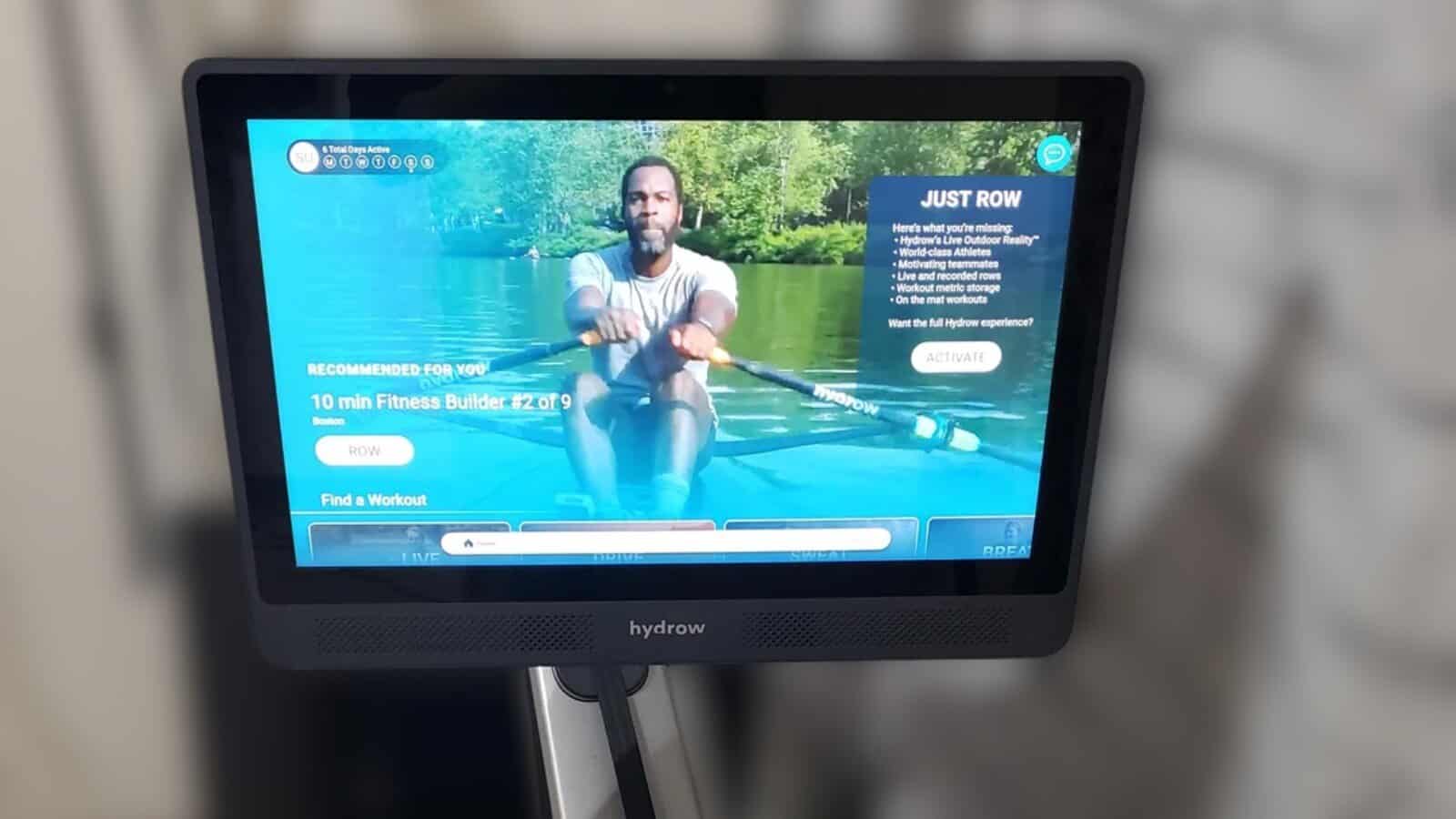
The 22-inch HD touchscreen is the Origin’s main differentiation from the Wave. It’s larger than the Wave’s 16-inch screen but smaller than the Arc’s 24-inch display.
Screen Size and Quality
The screen is bright and responsive. Touch inputs register quickly, and the interface is smooth. The resolution is adequate, though you can see individual pixels if you look closely.
Is 22 inches the sweet spot? For rowing workouts, it’s noticeably more immersive than the Wave’s 16-inch screen without being as large as the Arc’s 24-inch display. You get a bigger view of the outdoor content and instructors.
For off-rower workouts, the 22-inch screen is genuinely better than the Wave’s smaller display. Yoga, strength training, and Pilates are easier to follow when you can see the instructor’s full body positioning clearly.
Screen Movement
The Origin’s screen rotates left and right and tilts up and down. This adjustability is crucial for off-rower workouts where you’re positioned beside the machine.
For rowing, I keep the screen tilted slightly upward. At 5’9″, this puts the screen in my direct line of sight. Taller users will want to tilt it further up.
The rotating screen is a significant advantage over the Wave’s fixed display. If you plan to use off-rower content regularly, this feature alone makes the Origin worth considering when it’s on sale.
Content Library Access
The Origin provides access to Hydrow’s full content library. Over 5,000 workouts including outdoor scenic rows, indoor studio sessions, live classes, strength training, yoga, Pilates, and more.
The outdoor rowing content is what makes Hydrow special. Filmed in real locations with instructors rowing on actual water, these workouts are immersive and genuinely enjoyable. I’ve rowed through waterways in Sweden, rivers in Prague, and coastal routes in Chile.
The $44/month membership is required. Without it, you’re limited to “Just Row” mode with basic metrics. At the Origin’s price point (especially when on sale), the membership is essentially mandatory but well worth it for the content quality.
What You Don’t Get: Advanced HydroMetrics
The Origin does not have the advanced HydroMetrics found on the Arc. You get standard workout metrics (split time, stroke rate, distance, calories, heart rate) but not the detailed AI-powered form analysis.
The Origin does have basic HydroMetrics feedback after workouts, similar to the Wave. You’ll see general performance insights, but not the deep precision/power/endurance breakdowns that the Arc provides.
For most users, this isn’t a dealbreaker. The standard metrics are sufficient to track progress and stay motivated. But if you’re a data enthusiast who wants detailed form analysis, the Arc is worth the premium.
Day-to-Day Living
The Origin’s size and weight create practical considerations similar to the Arc.
Space Requirements
In use, the Origin occupies 86 inches of length, 25 inches of width, and 47 inches of height. You’ll want at least 12 inches of clearance front and back, plus 18-24 inches on each side.
The Origin has the same footprint as the Arc, which means it’s noticeably larger than the Wave (80″ L x 19″ W x 43″ H).
If space is tight, the Wave’s more compact dimensions might be worth considering. If you have adequate space, the Origin’s size isn’t a problem.
Vertical Storage
Hydrow sells an upright storage kit for $80 (same as the Arc). With the kit, the Origin can be stored vertically, reducing the footprint to 86 inches high, 25 inches wide, and 33 inches deep.
At 145 pounds, vertical storage is physically manageable but not something you’ll want to do frequently. The Wave’s built-in vertical storage and 102-pound weight make it far more practical for regular repositioning.
The Origin has wheels on the front for rolling, but moving 145 pounds more than 10-15 feet gets tiring.
Cleaning and Maintenance
Maintenance is standard:
- Wipe down rail and seat after each session (30 seconds)
- Clean touchscreen weekly
- Check bolts monthly and tighten if needed
- Every six months, dust vents and inspect seat rollers
The electromagnetic resistance is sealed and maintenance-free. No water to change, no air filters to clean.
After months of regular use, the Origin requires minimal upkeep.
Direct Comparisons
Understanding how the Origin compares to its siblings is critical to making the right purchase decision.
When the Origin is on sale for less than or equal to the Wave’s price, the decision becomes straightforward.
Screen: 22 inches (Origin) vs 16 inches (Wave). Noticeably larger and more immersive for both rowing and off-rower workouts.
Screen Movement: The Origin’s screen rotates and tilts; the Wave’s is fixed. Meaningful advantage for off-rower workouts.
Build: The Origin uses aluminum and steel; the Wave uses polymer. The Origin feels more premium, though both perform identically.
Rowing Performance: Identical.
Portability: The Wave is 40+ pounds lighter and far easier to move and store.
My take: If the Origin is on sale for the same price or less than the Wave, get the Origin. You’re getting a larger rotating screen and metal frame at no premium. If the Origin costs $200+ more than the Wave, then the Wave’s portability and value make more sense unless you specifically want the larger screen.
The Arc costs $200-400 more than the Origin (depending on current sales). What do you get?
Screen: 24 inches (Arc) vs 22 inches (Origin). Slightly larger but not dramatically so.
HydroMetrics: The Arc has advanced AI-powered performance tracking. The Origin has basic HydroMetrics.
Build: Both use aluminum and steel. Essentially identical.
Rowing Performance: Identical.
My take: If you’re a data enthusiast who wants detailed form analysis, the Arc’s HydroMetrics is worth the premium. If you don’t care about advanced analytics, the Origin’s $200-400 savings makes sense, especially when it’s on sale.
The Concept2 costs $900-1,000 with no subscription required.
Feel: The Concept2 uses air resistance and is louder with a more tactile feel. The Origin is quieter and smoother.
Content: The Concept2 has no screen. The Origin is built around immersive content.
Metrics: The Concept2’s PM5 provides extensive, highly accurate data. The Origin provides standard metrics and basic HydroMetrics.
Cost: Over five years, the Concept2 is significantly cheaper (no subscription). The Origin costs around $4,535 total (assuming $1,895 sale price + $44/month x 60 months).
My take: Choose the Concept2 for raw performance data and lower cost. Choose the Origin (or Wave, or Arc) for engaging content and coaching.
Long-Term Durability
After months of regular use, the Origin has held up well.
What’s Holding Up
Frame and structure: No creaks, no rattles, no looseness. The aluminum and steel construction feels solid.
Seat and rollers: The seat glides smoothly with no degradation.
Handle and straps: No fraying or wear.
Touchscreen: Reliable with no issues.
Minor Issues
Bolt tightening: Every six months, I hand-tighten all bolts. A few loosen slightly with regular use (normal for fitness equipment).
Rail cleaning: If you don’t wipe down the rail regularly, minor cosmetic scuffing appears where the seat rollers contact the metal. Doesn’t affect performance.
Warranty Coverage
The Origin comes with a 5-year warranty on the structural frame and a 12-month warranty on components, electronics, and labor. Same as the Wave and Arc.
Hydrow support has been responsive when issues arise. Most problems are resolved through troubleshooting or by sending replacement parts.
Who Should Buy the Hydrow Origin
After extensive testing, here’s my honest assessment:
Buy the Origin if:
- It’s on sale for less than or equal to the Wave’s price (check frequently, as Hydrow discounts it often)
- You want a metal frame and rotating screen
- You plan to use off-rower content and want a larger screen than the Wave
- You don’t need the Arc’s advanced HydroMetrics
- You prefer the 22-inch screen size over 16 inches or 24 inches
Skip the Origin if:
- It’s at full price ($2,195) and not on sale
- You’re budget-conscious and the Wave is cheaper
- You want advanced performance analytics (get the Arc instead)
- You value portability and easy storage (get the Wave instead)
The Origin is an excellent rower. At the right price (which it frequently hits during sales), it becomes the best choice in Hydrow’s lineup for many users.
Final Verdict
The Hydrow Origin is a premium rowing machine with a unique pricing strategy that works in your favor if you’re patient.
The hardware is excellent. The rowing performance is smooth and responsive. The 22-inch rotating screen hits a sweet spot between the Wave’s compact 16-inch display and the Arc’s large 24-inch screen. The content library is massive and engaging.
At full price ($2,195), the Origin is hard to recommend. You’re sitting just $100 away from the Arc’s advanced features or $200 above the Wave without enough differentiation.
But Hydrow frequently discounts the Origin. When it drops to $1,795-1,895 (which it does regularly), the Origin becomes the smart choice for most buyers. You’re getting a premium metal-frame rower with a rotating screen at Wave prices or below.
My recommendation? If you’re shopping for a Hydrow, check the Origin’s current price. If it’s on sale for less than the Wave, buy it immediately. If it’s at full price, either wait for a sale or choose the Wave (for value) or Arc (for features).
Rating: 4.5/5
The Origin is an outstanding rowing machine that loses half a star only due to confusing list-price positioning. When purchased on sale (which is frequent), it’s easily a 5/5 value proposition.
FAQ
How often does the Origin go on sale?
Frequently. Hydrow appears to use the Origin as a promotional model, discounting it regularly by $200-400. If you’re interested in the Origin, sign up for Hydrow’s email list or check their website monthly. You’ll likely catch a sale within a few weeks.
Is the Origin worth buying at full price?
No. At $2,195, you’re only $100 away from the Arc (which adds meaningful features) or $200 above the Wave (without enough improvements to justify the premium). Wait for a sale.
At what sale price does the Origin become a good buy?
When it drops to $1,895 or below, the Origin becomes an excellent value. You’re getting a metal-frame rower with a 22-inch rotating screen at or below the Wave’s price.
Is the Origin’s rowing performance better than the Wave?
No. They use the exact same electromagnetic resistance system with identical performance. The Origin’s advantages are the larger rotating screen and metal frame, not better rowing quality.
Does the Origin have HydroMetrics?
Yes, basic HydroMetrics similar to the Wave. You’ll get general performance feedback after workouts. The Origin does not have the Arc’s advanced HydroMetrics with detailed precision/power/endurance analysis.
How much better is the 22-inch screen than the Wave’s 16-inch screen?
Noticeably better for both rowing and off-rower workouts. The 22-inch screen provides a more immersive view of outdoor content and makes it easier to see instructor demonstrations during yoga and strength training.
Should I buy the Origin now or wait for the Arc to go on sale?
The Arc rarely goes on sale. If you want the Arc’s advanced HydroMetrics, you’ll likely pay full price. If you’re patient and don’t need advanced analytics, wait for the Origin to go on sale and save $300-400.
Is the Origin quieter than the Arc?
Yes, noticeably. The Origin is quieter than the Arc (though not as quiet as the Wave). If noise is a primary concern and you want a metal-frame Hydrow, the Origin is your best option.
Can I use the Origin without the membership?
Technically yes, in “Just Row” mode with basic metrics. But you lose all content, saved workouts, challenges, and leaderboards. At the Origin’s price point (even on sale), the membership is essentially mandatory.
How does the Origin compare to a Concept2?
The Concept2 is louder, more tactile, has no screen, and costs $900-1,000 with no subscription. The Origin is quieter, smoother, built around immersive content, and costs $1,795-2,195 plus $44/month. Choose Concept2 for raw data and lower cost; choose Origin for engaging content.
Final Thought: The Hydrow Origin is a premium rowing machine that becomes the best choice in the lineup when you catch it on sale. Be patient, wait for a discount, and you’ll get exceptional value.

